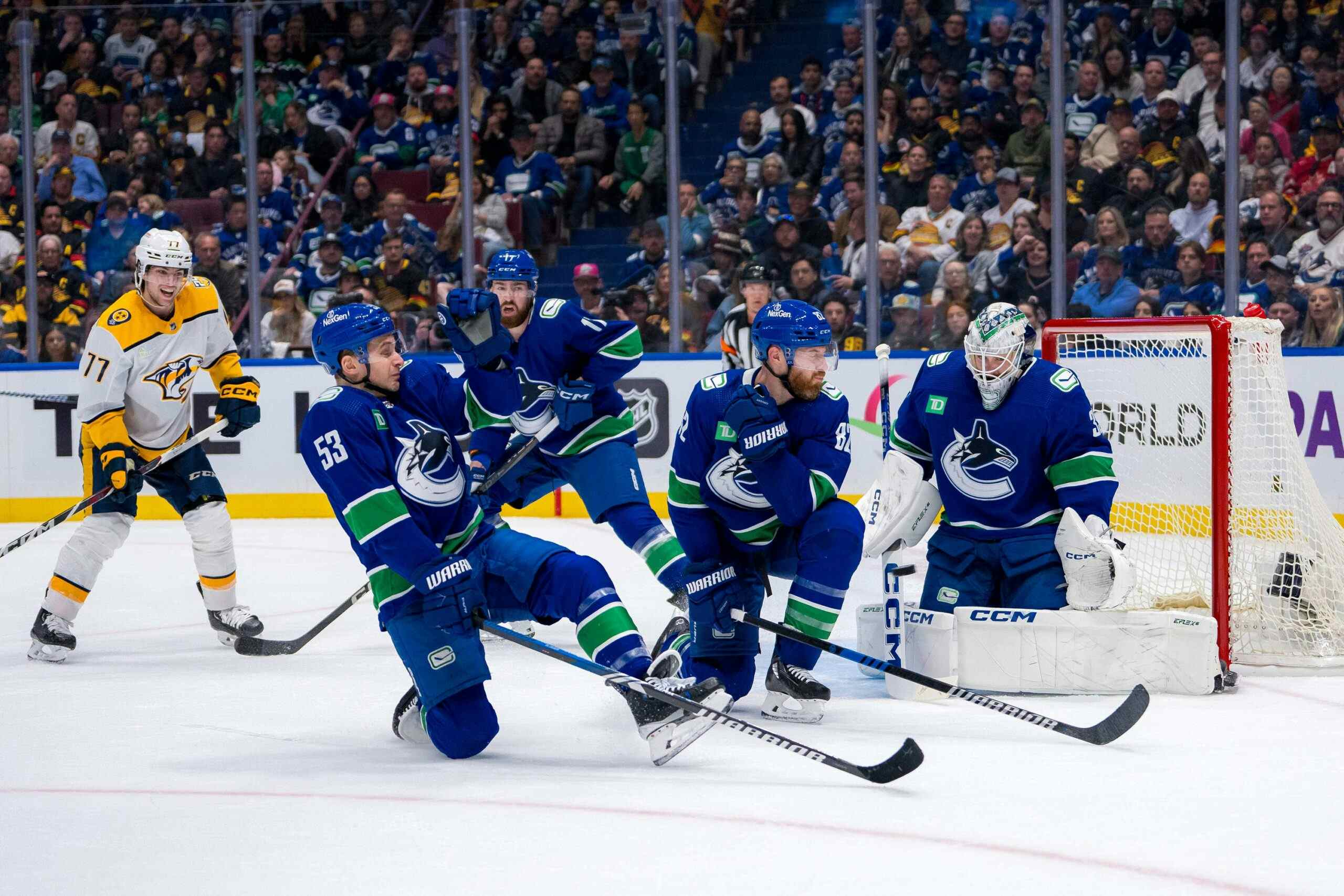Deep Dive: What Happened to Loui Eriksson?
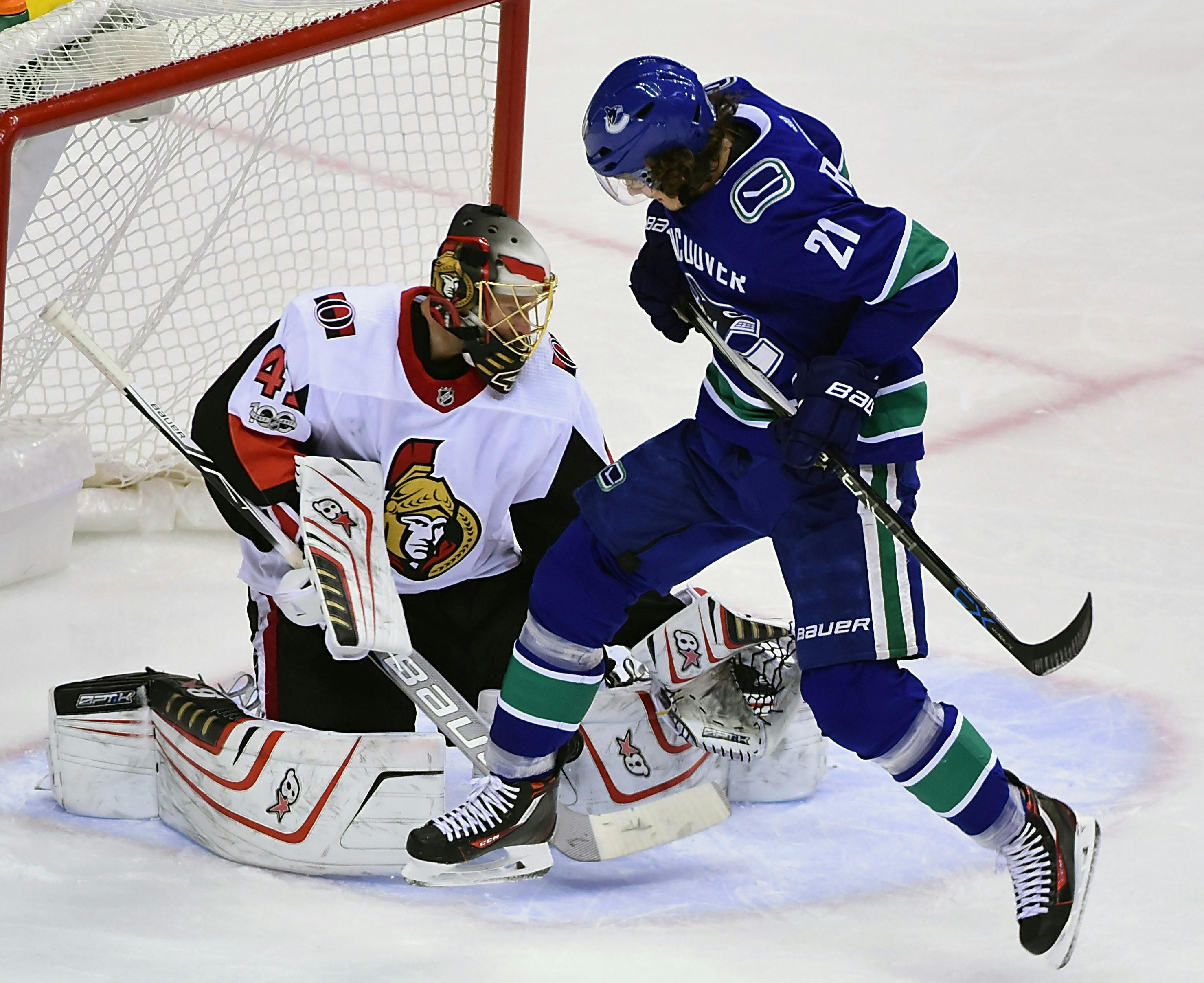
5 years ago
Loui Eriksson’s back-to-back disappointing seasons should be the type of thing that makes a player the poster boy for bad free-agent contracts. Instead, the market has been stunningly quiet about a player with an AAV of $6 million dollars and another four years left on his deal.
I can’t speculate as to why the topic has gone underreported in the mainstream media; but I can tell you that part of the reason he’s mostly escaped criticism from the blogosphere is that he hasn’t actually performed as badly as his counting stats might suggest.
| Player | GP | G | A | P | P/60 | CF% | relCF% |
| Loui Eriksson | 50 | 10 | 13 | 23 | 1.48 | 49.21 | +2.89 |
For the majority of his career, Eriksson’s had a positive shot impact. This season was no different, as Eriksson’s teammates generally performed better with Eriksson than they did away from him in terms of on-ice shot differential.
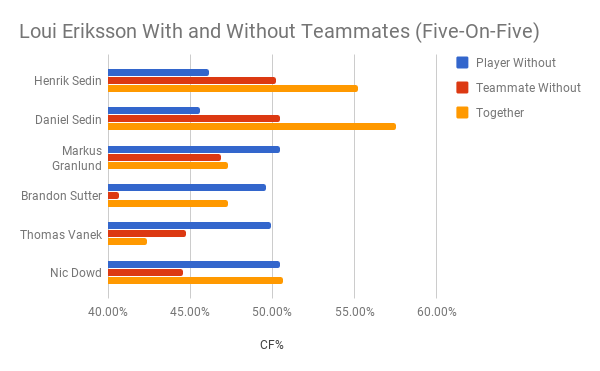

Overall, Daniel and Henrik Sedin performed better away Eriksson than he did away from them, but that’s not an indictment of Eriksson’s play. In fact, it actually helps explain why Eriksson’s offence has taken such a hit since signing with Vancouver. Together, the Sedins and Eriksson routinely controlled above 55% of the shot attempts at even-strength. They quietly dominated the opposition, even when the goals weren’t there. When Henrik and Daniel weren’t playing with Eriksson, they still got to play with each other and usually saw ice time with either an offensive driver like Thomas Vanek or Brock Boeser, or possession-driving winger in Jake Virtanen. When Eriksson was away from the twins, he was usually left with more offensively challenged linemates like Markus Granlund and Brandon Sutter. The Sedins also saw the league’s most extreme offensive deployment under Travis Green, and Eriksson’s numbers with and without them reflect the different ways that Travis Green utilized his forward lines.
Any discussion of Loui Eriksson’s time in Vancouver usually begins with a simple question: what happened? To answer that, first you have to answer the question of what type of player Loui Eriksson is in the first place.
Eriksson is perhaps the one of the most boring 30-goal scorers in NHL history. When looking at highlights from even the heyday of his career, you’ll see very little of the flash and creativity that’s a staple among the league’s other goal-scorers. Eriksson isn’t particularly fast, and he doesn’t have much of a shot. What he is great at is stick work in tight, specifically around the crease. Eriksson’s success has traditionally come from going to the net and either outmaneuvering the goaltender or chipping in a rebound. It’s that skill set that’s made him so successful on the man advantage, particularly in relation to how he’s fared at even strength.
Eriksson had a tremendous contract year and a fairly successful stint overall with the Boston Bruins, but his production on the power play helped disguise the fact that his 5v5 scoring pace has been on the decline since his trade out of Dallas. At this stage, the days of Loui Eriksson as a driver of even-strength offence are likely a thing of the past.
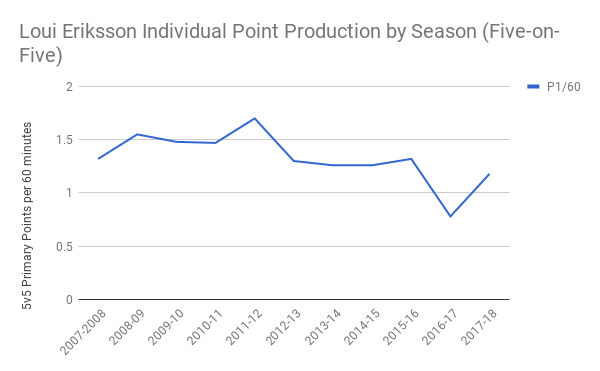
Despite being known as a goal-scorer, Eriksson’s even-strength offensive production has traditionally been more in line with what would be expected of a very good second-line winger. Eriksson’s first season in Vancouver was truly abysmal for a variety of reasons, but in 2017-18 his even-strength production rose back to just under the rate he saw for much of his time in Boston. What changed was that the Canucks’ power play improved drastically under Travis Green; but did so largely without Eriksson. Willie Desjardins actually used Eriksson a fair bit on the power play, but he was unable to replicate the success he’d had with previous clubs. With the addition of Brock Boeser and a new coaching staff that was no longer reluctant to utilize Bo Horvat on the first unit, Eriksson’s power play time took a huge hit. Eriksson saw the lowest PP TOI of his career, which helps to account in part for his poor counting stats.
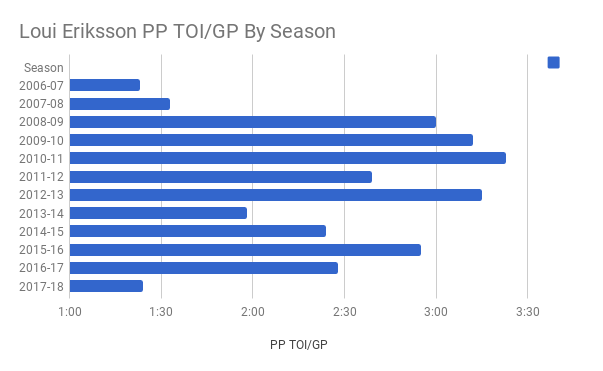
Even this doesn’t completely explain Eriksson’s drop off, however. Since coming to Vancouver, Eriksson’s 5v4 production has dipped as well. Eriksson may not have played much at 5v4 last season; but he also didn’t perform well either, failing to register a single goal and recording just three assists in just over 70 minutes of power play time. Some of this could just be due to age. While I wouldn’t completely discount that possibility, I also think it’s an insufficient explanation. The good news is, Eriksson hasn’t stopped going to the net. While his high-danger shots are down from where they were a few seasons ago, he’s still getting a lot of shots from the area where we’d expect him to do the most damage both at even-strength and up a man.

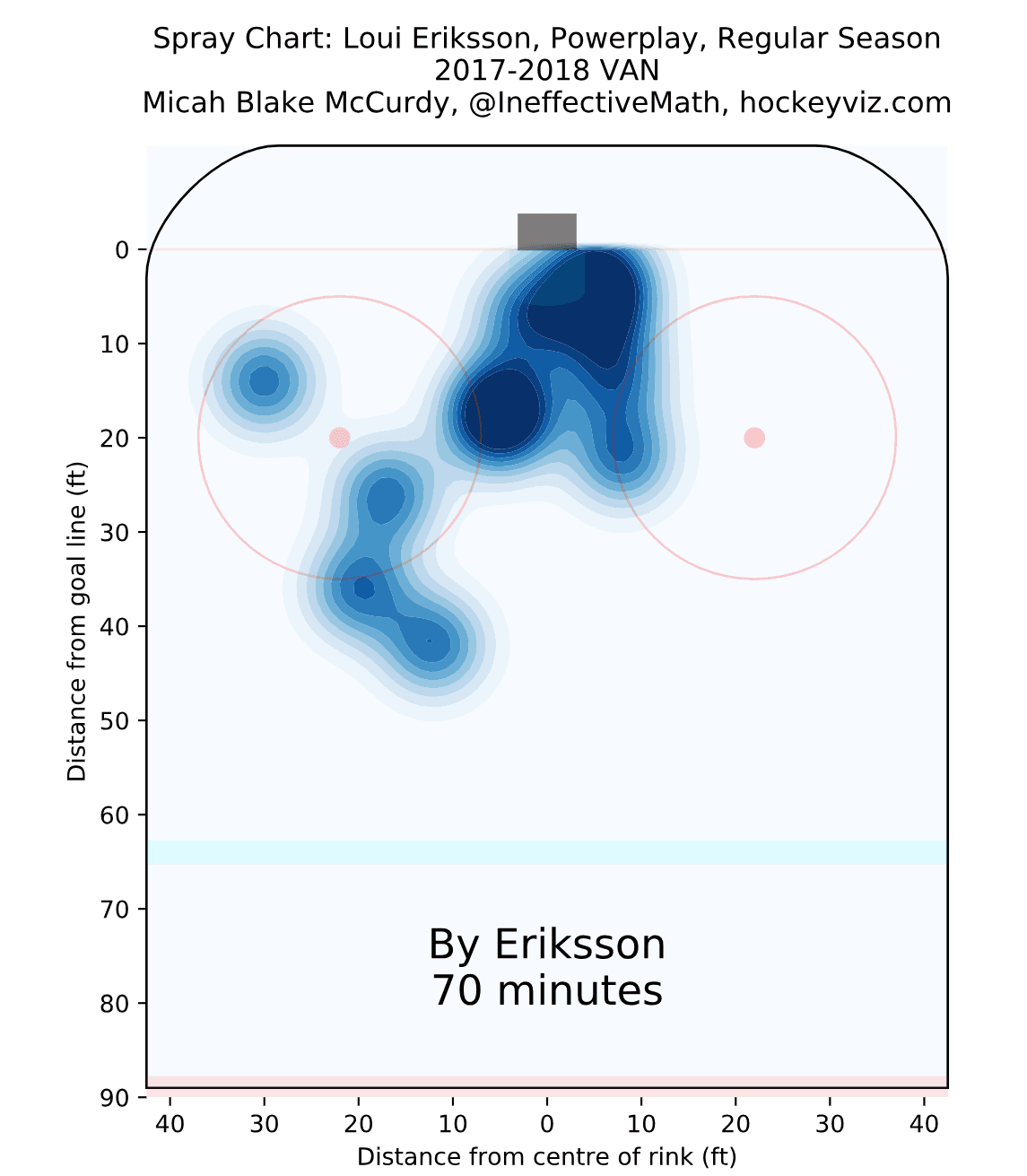
Because Eriksson has traditionally derived much of his production from so-called “garbage goals”, he’s traditionally converted on a high number of his shots. Since arriving in Vancouver, his shooting percentage has sunk from his career average of 13.2 to below 9%. Something else that’s changed for Eriksson is quality of his team’s power play. The Bruins have been one of the league’s top power play teams over the past five years, a trend that’s continued without Eriksson. It’s not a knock on him, but it’s clear he benefited more from the Bruins’ powerplay than it did from him.
The analytical work being done on the powerplay still lags a bit behind it’s even-strength counterpart. While we can look at things like shot generation, the numbers don’t always match up with the results. This is likely because success on the man advantage relies more heavily on shot quality. That being said, one could see why a high shot volume powerplay would be beneficial for Eriksson considering how much of his offence is generated off of traffic in front of the net. When compared against the Bruins’ powerplay from Eriksson’s stellar 30-goal campaign, the Canucks of the past two seasons come up short.
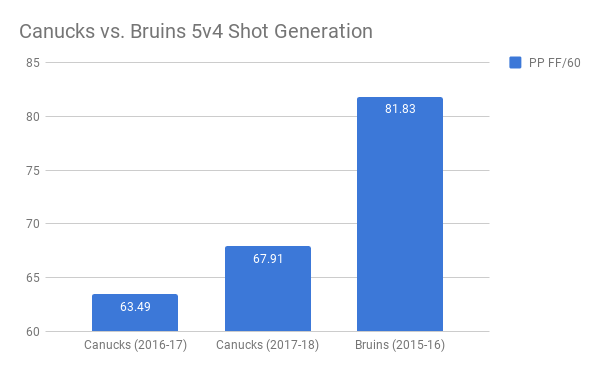
While the Canucks’ powerplay improved drastically under the Canucks’ new coaching staff, it had more to do with the addition of a one-shot scorer in Brock Boeser than it did with increased shot generation. (Although, to their credit, that improved as well.) The reason this is important with regards to Eriksson is that more shots equals more rebounds. Rebounds have been shown to create more scoring plays than just a straight shot, likely because goalies have a tougher time getting across to stop them. This is particularly important for a player like Eriksson, who does all his best work right in the goalie’s kitchen.
Four of the league’s top 60 rebound generators on the man advantage played for Boston in 2015-16: David Krejci, Patrice Bergeron, Torey Krug, and Ryan Spooner. They also happened to be Eriksson’s four most common linemates at 5-on-4. They combined to create 30 rebounds on the man advantage that season. In Eriksson’s first year with the Canucks, the team’s top four rebound-generators combined for just 19. In his most recent season, the Canucks actually improved their rebound generation significantly thanks largely to the additions of Brock Boeser and Sam Gagner; but both seasons had one thing in common: Eriksson didn’t see ice time with the team’s top rebound generators. In his first season, this was just because Willie Desjardins wasn’t particularly great at putting his players in a position to succeed. This season was different. Green had a number of offensive options at forward on the power play, and Eriksson just didn’t make the cut. He would have benefited greatly from playing with a player like Boeser, but they played just 3:40 together on the man advantage.
Moving forward, Eriksson could stand to benefit the most from the Sedins’ retirement. With two spots opening up on the team’s first unit, Eriksson is likely to not only see more power play time, but see it with players that can complement him.
It’s also worth noting that Eriksson played well for long stretches of the 2017-18 season. In the latter half of November, Eriksson had 10 points in as many games and looked to be on pace for another 50-point season. Then he went ice cold for over a month. His pace looked to be improving towards the end of January and into February until he sustained a season-ending injury against Arizona. He still finished with just one less point than his first season in Vancouver despite playing 15 less games. There’s a case to be made Eriksson was having his bounce-back season, he just couldn’t stay healthy enough to see it through. For so many reasons, a production increase for Eriksson is long overdue. Unfortunately, if he can’t stay healthy, none of this matters.
Conclusion
That was a lot of numbers, a lot of charts, and a lot of information. So, to summarize:
- Eriksson remains a good two-way player at even-strength.
- While he’s had some bad luck, it’s important to note that his 5v5 production has been on the decline for many years.
- If Eriksson is going to improve his offensive output, it’s going to have to be largely on the man advantage. Unfortunately, he’s seeing less time at 5v4 than ever, which could be a problem.
- Eriksson benefits greatly at 5-on-4 from playing with players who can generate rebounds. Unfortunately, he hasn’t gotten to do that consistently.
Eriksson’s first two seasons in Vancouver have been a good case study in the importance of organizational symmetry and a strong pro scouting department. Eriksson hasn’t really been put in a position to succeed thus far in Vancouver, either because the organization targeted him for the wrong reasons (i.e. to be an offensive driver on his own rather than a complimentary player), or because the coaching staff wasn’t in line with management on how he should be utilized.
All hope is not lost with regards to Eriksson. He’s due for a run of good luck, and there are signs that he could benefit greatly from some of the forthcoming changes. Travis Green has shown in his first year that he’s much better at playing to the strengths of his roster than Willie Desjardins was. He’s never going to be worth that contract, but returning to the realm of 20-goal scorer isn’t out of the question. Don’t be surprised if Eriksson finally has that bounce-back season.
Author’s note: This article was originally intended to be Loui Eriksson’s entry in the Year in Review series. Because it expanded well beyond the usual scope of a YIR piece, I decided it deserved to stand on it’s own. As a result, to avoid redundancy, there will be no “official” Loui Eriksson Year in Review this year.

